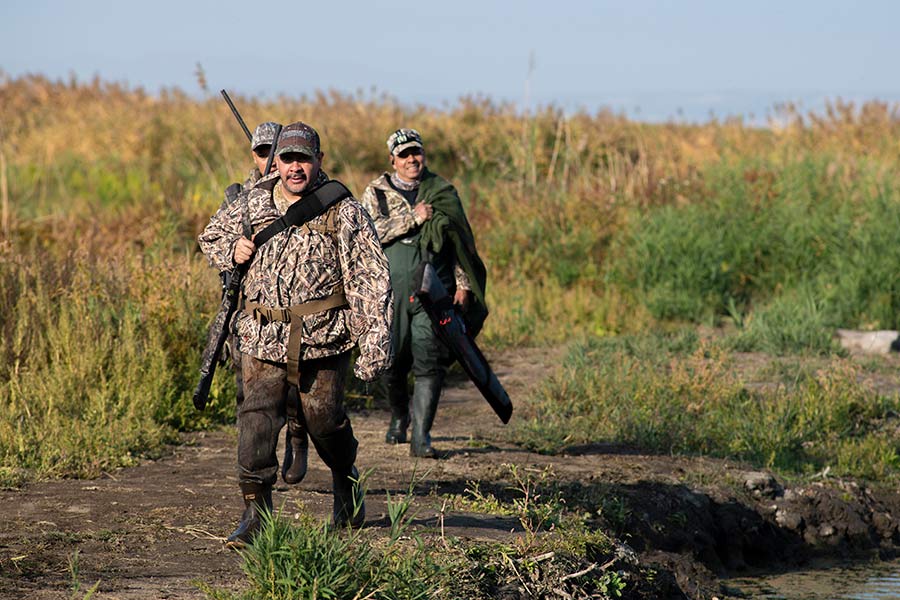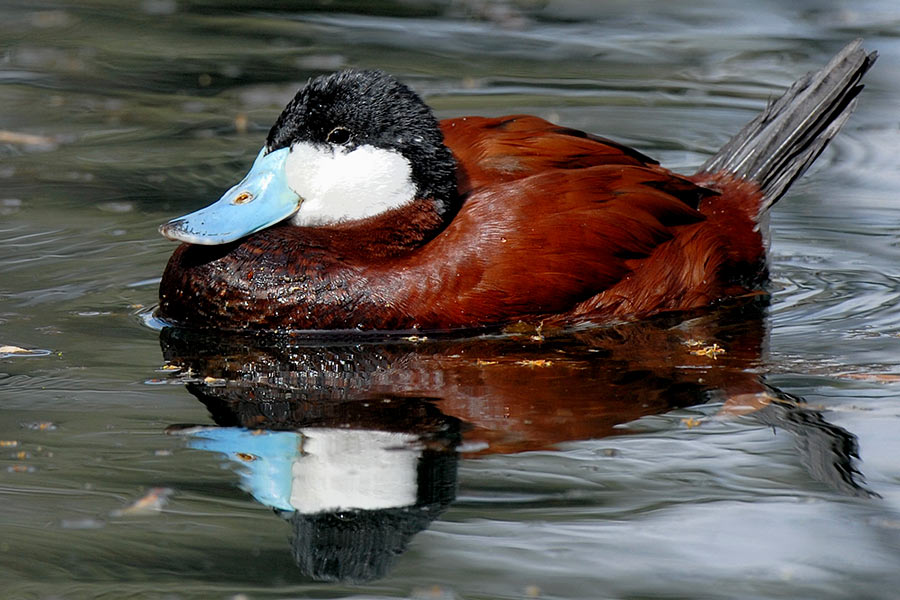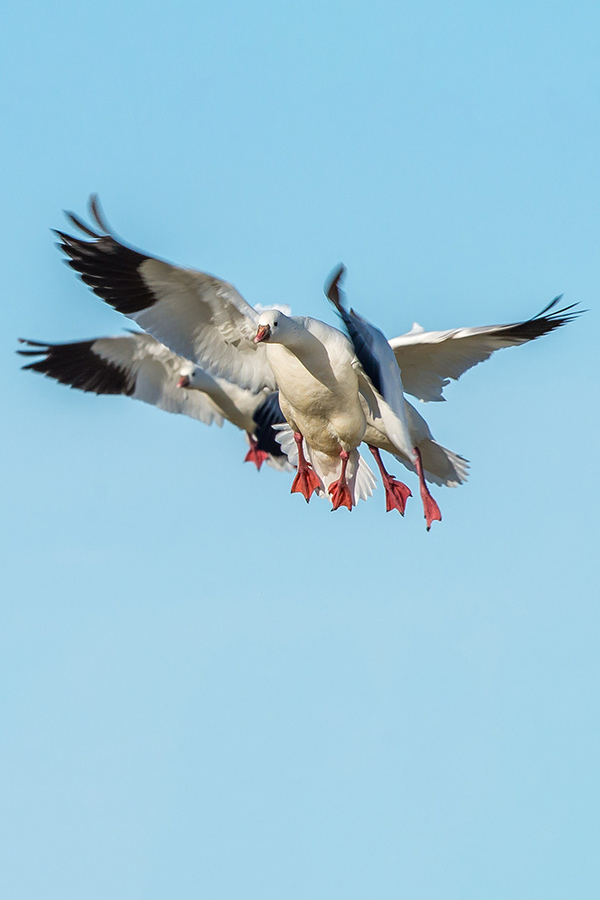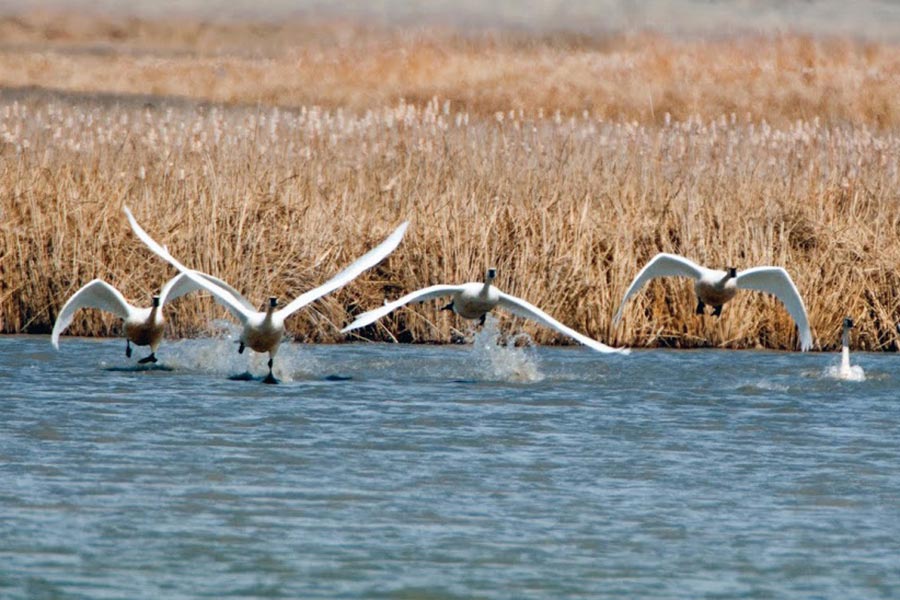What hunters should know about Utah's 2022 waterfowl hunts
Salt Lake City — It's a quiet, still morning as you sit near the edge of a lake in your blind. You hear some birds in the distance and turn your head to see several ducks flying toward you. Your heartbeat quickens, and you slowly raise your shotgun. Waterfowl hunting season is finally here.
With the exception of swans (which require a permit from the hunt drawing that ended July 20), the rest of the waterfowl hunts in Utah are open to anyone with a Utah hunting license. However, you are also required to have a Harvest Information Program (HIP) number to hunt any waterfowl in Utah, and a federal duck stamp if you are 16 years of age or older. You can register for a free HIP number on the Utah Division of Wildlife Resources website. You can purchase a duck stamp from your local post office, various license agents or by phone. The phone number is 1-800-782-6724. (Duck stamps are not available at DWR offices.)
If you are planning to hunt ducks, geese or swans this fall, here is what you should expect this year, some hunting tips for each species, and when the various seasons will open:
Ducks
Duck populations in Utah are doing OK this year, but numbers across North America have decreased due to drought impacts. There were fewer ponds available for nesting last year, which led to a decrease in reproduction.
"Many of the core breeding areas for most duck species were dry last year due to drought conditions, so there was very low production last year," DWR Assistant Wildlife Program Chief Blair Stringham said. "There should be more young birds migrating through Utah this fall, but hunters should expect to see fewer ducks overall, compared to the last 10 years."
Typically, about 15 duck species can be found in Utah. Details and photos of each species can be found in the 2022–23 Utah Waterfowl Guidebook.
"Hunters can greatly improve their success during the duck hunt by spending some time scouting before each hunt," Stringham said. "Learning where and when birds are in a specific location can allow hunters to be where the birds want to be, when they want to be there, and will greatly increase the number of birds they harvest."
For instance, each duck species uses different types of habitats. Diving ducks, like canvasbacks and redheads, like big, open waterbodies. Puddle ducks, like teal and shovelers, are generally found in shallow water. And species like mallards can be found just about anywhere.
"Think about the species you are hunting and then look for them in the habitats they want to be in," Stringham said. "If you aren't finding the species you are targeting, move around to different areas until you find them."
Calls are also an effective tool in helping hunters be successful during duck hunts. Most hunters use a traditional duck call that sounds like a mallard hen. Experimenting with other sounds, such as wigeon or pintail whistles, can also increase success. Dogs are great at helping hunters retrieve downed birds and will increase your chances of finding ducks that fall in thick cover.
The general-season duck hunt runs from Oct. 1 to Jan. 14 in Utah's northern zone and runs from Oct. 15 to Jan. 28 in the southern zone. The northern zone youth waterfowl hunt took place on Sept. 17, and the southern zone youth hunt will happen on Oct. 1. Check the Utah Waterfowl Guidebook for the boundaries of the two zones and to see the bag limits for ducks.
Geese
Canada goose populations are doing well this year and had higher reproduction rates than last year.
"Hunters should see lots of geese early in the season," Stringham said. "Migrating geese will begin showing up around mid-late November. Geese continue to increase in the Pacific Flyway — which includes Utah — and hunting should be good this year. Snow geese numbers have also continued to increase in the Pacific Flyway."
An important tip for success during the geese hunts is to use a good call.
"Calling is a very important part of goose hunting," Stringham said. "Geese are very social birds, so being able to sound like a goose can help hunters harvest more birds."
Dark and white-fronted geese season dates:
- Northern area: Oct. 1-8 and Oct. 26 to Jan. 31, 2023
- Wasatch Front area: Oct. 1-8 and Nov. 10 to Feb. 15, 2023
- Eastern Box Elder area: Oct. 1 to Jan. 14, 2023
- Southern area: Oct. 15 to Jan. 28, 2023
Light geese season dates:
- Eastern Box Elder, Northern and Wasatch Front goose areas: Oct. 15 to Dec. 22 and Feb. 1 to March 10, 2023
- Southern area: Oct. 25 to Dec. 15 and Jan. 15 to March 10, 2023
The youth waterfowl hunt that will be held on Oct. 1 in the southern zone will allow dark goose and white-fronted goose hunting. Check the Utah Waterfowl Guidebook for the specific zone boundaries and bag limits.
Hunters should also note that most light goose hunting takes place on private property. Make sure to get written permission from landowners before hunting on their property.
Swans
Tens of thousands of swans move through Utah every fall on their way to their wintering grounds in California. Tundra swan populations in the Pacific Flyway are still doing well, and hunters can expect to see similar numbers as in previous years in Utah.
"Swans migrate and stop over at the same locations each year," Stringham said. "Traditional hunting areas, such as the Bear River Migratory Bird Refuge, will hold swans beginning the first part of November until the marshes freeze up."
Hunters should also be aware that swans will leave resting areas to feed during the morning and late afternoon, and throughout the day as temperatures get colder. So scouting before the hunt can help hunters determine when swans are moving and know what times of day to hunt.
"Hunting along a swan's flight path, or in their feeding locations, will increase your odds of harvesting a swan," Stringham said.
Hunters should also be sure of the swan species they are targeting before attempting to harvest one. Trumpeter and tundra swans both migrate through Utah and are both legal to harvest. Each species can be identified by size and sound. Trumpeter swans are significantly larger than tundra swans. Trumpeter swans do not have a yellow-colored area near their eyes, and they also make a distinctive trumpet-like sound, hence their name.
Utah is one of only nine states in the U.S. that allows hunting for swans. Due to the low population size of trumpeter swans in the Greater Yellowstone area, the U.S. Fish and Wildlife Service sets an annual harvest quota for the number of trumpeter swans that can be harvested in Utah.
Similar to last year, there is a federal quota of 20 trumpeter swans that can be harvested in Utah. The swan hunting season has been closed early for the past three years in Utah because the federal quota for trumpeter swans was reached. Hunters with a permit can legally take one trumpeter or tundra swan; however, hunters who harvest trumpeters will now face a waiting period before they can obtain another swan permit.
In December 2021, the Utah Wildlife Board approved a rule that prohibits someone from being able to apply for a swan hunting permit for several years if they harvest a trumpeter swan. Now, youths who harvest a trumpeter swan must wait three years until they can apply for a swan permit, and adults must wait five years.
The general swan season runs from Oct. 1 to Dec. 11. Those with a swan permit may harvest only one swan during the 2022 season.
Avian influenza
High pathogenic avian influenza viruses are very contagious among birds and can cause rapid and high mortality in domestic birds, such as chickens, turkeys and domestic ducks. These viruses occasionally kill wild birds, as well. The most common wild birds impacted by the virus are typically waterfowl, shorebirds, raptors and scavengers (which include birds like hawks, owls, ravens and vultures). There are usually few symptoms in waterfowl and shorebirds, but the virus can kill raptors and scavengers quickly.
As of Aug. 30, 2022, a total of 44 birds and two red foxes have tested positive for avian influenza in nine counties. The birds infected with the virus in Utah include raptors and waterbirds, specifically Canada geese, great horned owls, hawks, pelicans, turkey vultures, grebes, gulls and ducks.
"We have seen several cases of avian flu in Canada geese during the late summer," Stringham said. "We haven't seen any large die-offs, so it hasn't had a significant impact on local populations so far. Hunters should take precautions while out in the field this fall, and if anyone finds a group of five or more dead waterfowl, they should report it to the nearest DWR office and absolutely make sure not to touch the birds or pick them up."
If you are planning to hunt waterfowl this fall, here are some tips to keep yourself and your hunting dog safe:
- Do not harvest, handle or eat any animal that appears sick.
- Field dress game animals in a well-ventilated area or outdoors.
- Avoid direct contact with the intestines.
- Wear rubber or disposable latex gloves while handling and cleaning birds. Wash your hands with soap and water, and thoroughly clean all knives, equipment and surfaces that come in contact with the birds. Disinfect using a 10% chlorine bleach solution.
- Keep your game birds cool, clean and dry.
- Do not eat, drink or smoke while cleaning game or handling animals.
- All game meat should be thoroughly cooked before eating (well-done or 165° F).
- Dogs are susceptible to HPAI, but don't often show clinical signs. Though the risk of infection is low, visit the DWR website to identify the locations with active cases of avian flu in wild birds and avoid those areas when using retrievers. Consult your local veterinarian if your dog exhibits any respiratory symptoms.
- If you have domestic poultry, keep them separated from the wild bird carcasses you have harvested, and do not handle poultry after handling wild birds.
For more information about the current avian flu outbreak in wild birds, visit the DWR website. You can also view all the latest cases of avian flu in wild animals on the DWR website.
Waterfowl management areas
There are more than 20 waterfowl management areas (WMAs) throughout Utah that are owned and managed by the DWR. The WMAs opened to the public on Sept. 15.
Hunters should note that the ongoing drought conditions have decreased access to some of the WMAs and that hunting will be impacted at some of the WMAs due to decreased water. For specific details and condition reports about the WMAs, visit the DWR website. Be sure to check the conditions before attempting to launch an airboat.
"The water levels at the Great Salt Lake are at an all-time low, which has decreased food resources for birds at the lake and in the surrounding wetlands," Stringham said. "Because of that, it's likely that waterfowl will migrate through Utah quicker this year, which will make hunting more difficult later in the season."
Waterfowl Slam
If you'd like to add some fun and challenge to your hunt, consider completing the Waterfowl Slam. Hunters earn a slam by completing different requirements, such as harvesting a group of species in a certain time period or location. There are currently 10 slams with different levels of difficulty, so you can find a variety of fun, unique challenges. Along with trying something new, hunters who complete the slam can also earn colorful, collectible leg bands.
The money earned from the slam is used to complete habitat-improvement projects on the different WMAs across the state. Learn more about the Waterfowl Slam on the DWR website.




















